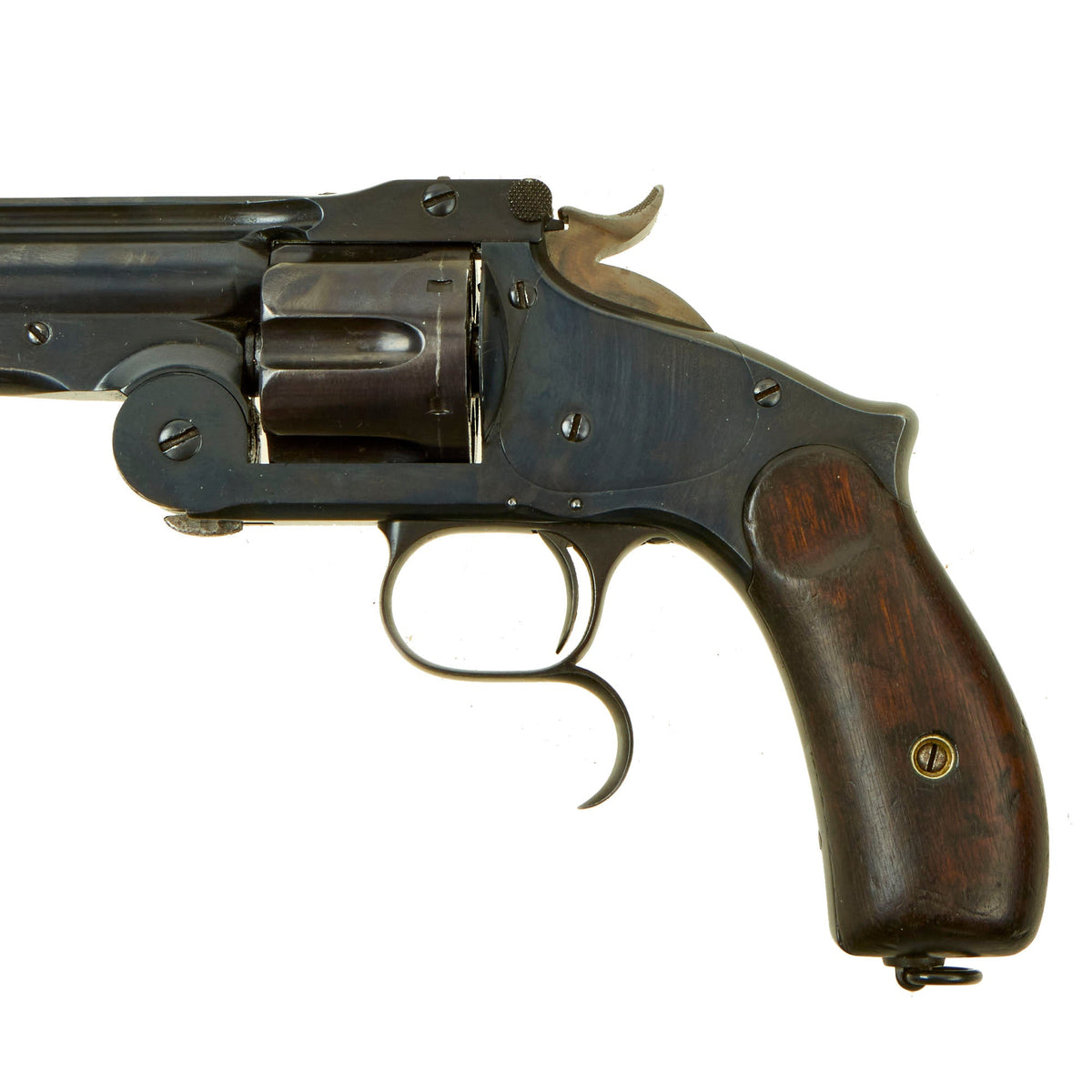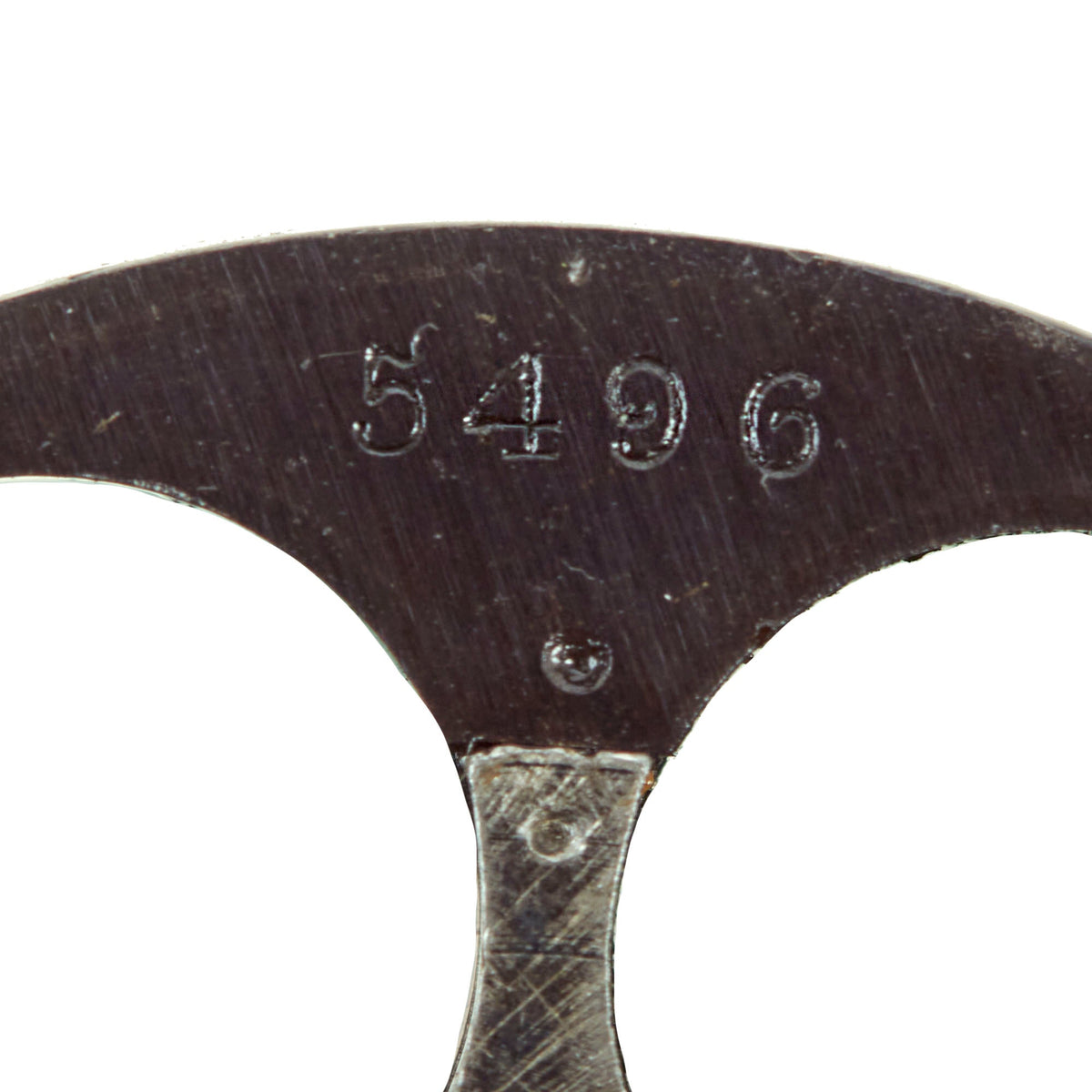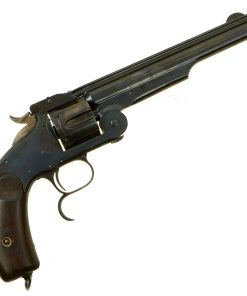Original Excellent U.S. Smith & Wesson Japanese Army Contract No. 3 Russian 3rd Model .44cal Revolver – matching serial 5496 Original Items
$ 4.195,00 $ 1.048,75
Original Item: Only One available. This is a fantastic example of a very rare Revolver to find, and only the first example that we have had the pleasure of handling! This is a very nice Smith & Wesson “New Model” No. 3 revolver in .44 Russian caliber, which bears an Imperial Japanese Army inspection stamp on the top of the barrel rib, just behind the patent markings.
As a result of the “Meiji Restoration” that ended the Tokugawa shogunate and returned power to the Emperor, the country began a period of “Enlightened Rule.” Japan ended its long isolation, and began a policy of modernization across all aspects of life. This of course included the military, and they began to import larger numbers of small arms, as their domestic arms production industry was only in its infancy. These came from all over the world, which of course would include the large industrial capacity of the United States.
The Japanese military adopted the top-break .44 caliber “Russian” Model 3 Smith & Wesson revolvers as the “No. 1 Model Break Open Handgun”, and would proceed to acquire several thousand of these over the next three decades. Due to the fact that these purchases took place over time, the guns technically belonged to four different model classes: Model 3 Russian 2nd Model, Model 3 Russian 3rd Model, New Model No. 3 Single Action and New Model No. 3 Frontier. However as these all used the same .44 S&W “Russian” cartridge and only had minor differences mechanically and visually, the Japanese military kept the same designation for all.
The first of the Smith & Wesson Model 3 revolvers to be acquired by the Japanese government were some 5,000 Smith & Wesson Model 3 Russian 2nd Model revolvers that were purchased from the London based firm of H. Ahrens, who had offices and warehouse in Yokohama for the purposes of engaging in the Asian trade. These guns were purchased circa 1878 and shipped during the following months in 1878-1879. Examples of these revolvers are known with both Japanese Naval and Army markings. The next group of Japanese military purchased Smith & Wessons were some 1,000 Model 3 Russian 3rd Model revolvers that were again provided by H. Ahrens of Yokohama, and were shipped during 1878.
This particular example is one of the early Number 3 Russian Models purchased for the Army and shipped in 1879. While any of the Japanese contract Smith & Wesson’s are quite rare, the overwhelming majority of examples found on the modern collector market are Navy-marked; making this Army-purchased example extremely rare. For more complete information on the history of these revolvers, please see Japanese Imported Arms of the Early Meiji era by Francis C Allan, Chip Goddard, Takehito Jimbo, Doss H. White, and Dr. Stanley Zielinski.
This example is in absolutely fantastic condition, still showing over 90% of the original factory bluing, with the case hardening still visible on the hammer. It features the original walnut grips usually seen on the army examples, and has a full length 7″ barrel and cylinder capacity of 6 shots, functioning in single-action only. We have confirmed the caliber with cartridges to be .44 Russian, and the top of the barrel bears all the S. & W. patent dates up to 1875:
§ SMITH & WESSON SPRINGFIELD MASS. U.S.A. PAT. JAN.17&24.65 JULY 11.65 AUG.24.69 JAN.19.1875 REISSUE JULY 25.1871 §
The “reissue” marking at the end is the definitive marking for identification, only seen on one of the 9,000 Russian Models (both Second and Third models) produced, with the 1875 patent date verifying that it is the third model / type. The majority of the “Reissue” Russian production was consumed by foreign martial contracts, particularly to Imperial Japan and Turkey, with a much smaller number entering the commercial market. The Bone grips on this example suggest it is one of the few that was dispersed in the U.S. commercial market.
The revolver is marked with matching serial number 5496 on the bottom of the grip, the rear of the cylinder, the rear of the barrel, on the barrel latch, and even on the inside of the right grip scale, all the places it should be marked. There is also an 1874 marking on the bottom of the grip, but we do not know if this is an arsenal marking or something else, as it would not make sense for it to be a date.
As mentioned previously, the revolver truly looks fantastic, showing very little wear of any kind, just a bit of oxidation in areas, such as near the cylinder and under the grips. The revolver cycles beautifully, with crisp indexing and a solid cylinder lock. The action breaks open correctly, with the ejector presenting properly, snapping back when the action is fully open. The bore on the revolver is in excellent condition, showing a bright finish with crisp lands and grooves. We very rarely see bores this good on revolvers from this period, and it looks to barely have been used.
This is a Top-break revolver making loading extremely easy and frankly a much better system than the side loading Colts and Mervin & Hulbert revolvers. This was the same model revolver that the famous Lawman Wyatt Earp used in the Gunfight at the O.K. Corral on October 26th 1881.
A fantastic condition Japanese Army Contract “No.3 Russian Third Model” Smith & Wesson revolver with some great research potential. Ready to add to your collection and display!
Specifications:
Years of Manufacture: c.1878
Caliber: .44 Russian
Ammunition Type: Centerfire Cartridge
Barrel Length: 7 inches
Overall Length: 12 1/2 inches
Action: Single Action
Feed System: 6 Shot Revolver
History of the Smith & Wesson Model No. 3
The Smith & Wesson Model 3 was a single-action, cartridge-firing, top-break revolver produced by Smith & Wesson from circa 1870 to 1915.
It was produced in several variations and sub-variations, including both the “Russian Model”, so named because it was supplied to the military of the Russian Empire (41,000 No. 3’s were ordered in .44 caliber by the Imperial Russian Army in 1871), and the “Schofield” model, named after Major George W. Schofield, who made his own modifications to the Model 3 to meet his perceptions of the Cavalry’s needs. Smith & Wesson incorporated these modifications into an 1875 design they named after the Major, planning to obtain significant military contracts for the new revolver.
The S&W Model 3 was originally chambered for the .44 S&W American and .44 Russian cartridges, and typically did not have the cartridge information stamped on the gun (as is standard practice for most commercial firearms). Model 3 revolvers were later produced in an assortment of calibers, including .44 Henry Rimfire, .44-40, .32-44, .38-44, and .45 Schofield. The design would influence the smaller S&W .38 Single Action that is retroactively referred to as the Model 2.
In 1877, S&W discontinued production of its other Model 3s such as the American, Russian, and Schofield—in favor a new improved design called the New Model Number Three. This new model has a longer cylinder allowing it to fire longer cartridges. Standard chambering was .44 Russian, although other calibers were offered on special order or in related models such as the .44-40 Frontier Model, the .32-44 & .38-44 Target Models, and the very rare .38-40 Winchester Model.
Fast Shipping with Professional Packaging
Thanks to our longstanding association with UPS FedEx DHL, and other major international carriers, we are able to provide a range of shipping options. Our warehouse staff is expertly trained and will wrap your products according to our exact and precise specifications. Prior to shipping, your goods will be thoroughly examined and securely secured. We ship to thousands clients each day across multiple countries. This shows how we're dedicated to be the largest retailer on the internet. Warehouses and distribution centres can be located throughout Europe as well as the USA.
Note: Orders with more than one item will be assigned a processing date depending on the item.
Before shipping before shipping, we'll conduct a thorough inspection of the items you have ordered. Today, the majority of orders will be delivered within 48 hours. The delivery time will be between 3-7 days.
Returns
The stock is dynamic and we cannot completely manage it because multiple stakeholders are involved, including our factory and warehouse. So the actual stock may alter at any time. It's possible that you may not receive your order once the order has been made.
Our policy is valid for a period of 30 days. If you don't receive the product within 30 days, we are not able to issue a refund or an exchange.
You can only return an item if it is unused and in the same state as the day you received it. You must have the item in its original packaging.
Related products
Uncategorized
Uncategorized
Uncategorized
Uncategorized
Uncategorized
Uncategorized
Uncategorized
Uncategorized
Uncategorized
Uncategorized
Uncategorized
Uncategorized
Australian WWII Owen MK1 Machine Carbine SMG Custom Fabricated Replica with Sling Original Items
Uncategorized
Uncategorized
Uncategorized
Uncategorized













































































